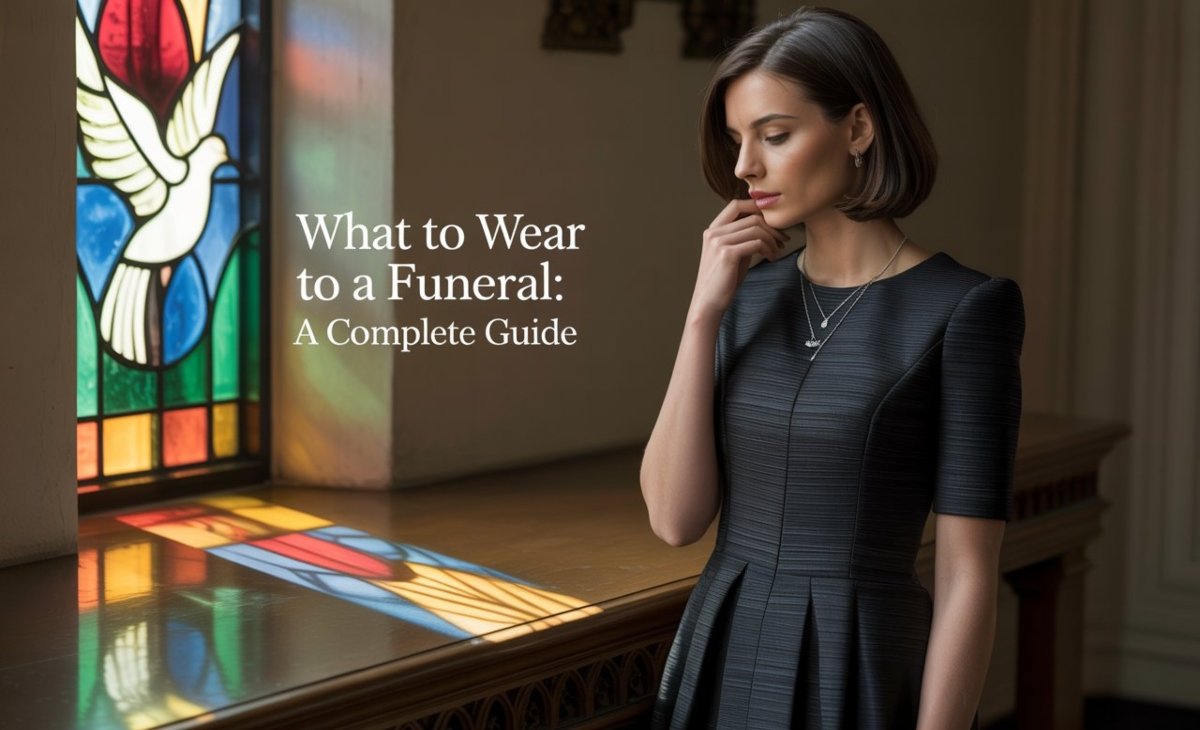Attending a funeral is an emotional experience. It is a time to honor the life of someone who has passed away while also offering support to grieving loved ones. During such occasions, even small details—like what you choose to wear—can carry a lot of meaning. Deciding what to wear to a funeral is not simply about looking appropriate; it is about showing respect, empathy, and understanding of traditions. Your attire sends a quiet but powerful message of compassion, making it an important part of funeral etiquette.
The Importance of Funeral Attire
Funerals are solemn gatherings. The clothing people wear often reflects the mood of the occasion. Dark, muted tones signal mourning and respect, while modest styles show thoughtfulness toward those grieving. While fashion normally allows for personal expression, funerals are not the place to stand out. Instead, the goal is to blend in quietly and support the atmosphere of reflection.
Understanding this helps take some of the pressure out of choosing what to wear. With a few simple guidelines, you can feel confident that your clothing is both respectful and appropriate.
Traditional Expectations Around Colors
Color choices are often the first thing people think about when preparing for a funeral. For many Western traditions, black has long been the standard. It conveys seriousness and dignity, making it the safest option if you are unsure. If black is not available, navy blue, charcoal gray, or other dark neutrals are equally appropriate.
However, funeral attire is not the same everywhere. In some cultures, white is preferred over black. For example, Hindu and Buddhist funerals often encourage white clothing, which symbolizes purity and rebirth. In other regions, families may request brighter colors to celebrate the personality of their loved one. The key is to pay attention to the family’s wishes or the cultural context of the service.
Dressing with Modesty and Simplicity
When considering what to wear to a funeral, modesty matters as much as color. Clothing should be simple and understated, never flashy or revealing. For men, a dark suit with a tie is traditional, though a button-down shirt with dress slacks is also acceptable if a suit is not available. Women often choose a modest dress, skirt, or slacks paired with a blouse or sweater. Low-key accessories, closed-toe shoes, and muted fabrics help create a respectful look.
The goal is to ensure your presence feels appropriate without drawing unnecessary attention. By keeping your clothing simple, you allow the focus to remain on the memory of the person being honored.
Balancing Respect with Comfort
Funeral services can be emotionally draining and physically long. Many involve moving between indoor chapels and outdoor burial sites, which means clothing should be practical as well as respectful. Breathable fabrics make a difference if the service takes place in warmer weather, while layers help during colder months.
Shoes are also an important consideration. Funerals often require standing for long periods or walking across grass, gravel, or uneven ground. Choosing comfortable, polished shoes ensures you can participate fully without distraction. Comfort does not mean casual—rather, it means being thoughtful about how long you will wear the outfit.
Religious and Cultural Considerations
Not all funerals follow the same expectations. Religious traditions often influence clothing choices, and showing awareness of these practices demonstrates sensitivity. In Jewish funerals, men commonly wear a head covering, and modest attire is expected for everyone. Muslim funerals emphasize modesty as well, with women often covering their heads and wearing long sleeves. At Hindu services, white is more appropriate than black, while Christian funerals usually follow the traditional dark-clothing standard.
What to Wear to a Funeral add another layer of formality. Service members may wear uniforms, while civilians are expected to dress with the same level of dignity. Increasingly, families also plan non-traditional or “celebration of life” services. In those cases, they may request attendees wear bright colors or something meaningful to the loved one. Whenever in doubt, checking with the family or reviewing the service details is the best way to avoid misunderstanding.
Small Details That Matter
Clothing is not only about shirts, suits, or dresses. Accessories and personal grooming also contribute to the overall impression. Subtle jewelry, such as a wedding ring or simple necklace, is acceptable, but large or flashy items should be avoided. Strong perfumes or colognes may overwhelm others, particularly in small or crowded spaces, so it is best to go without or use very lightly.
For outdoor services, practical items like an umbrella or a pair of sunglasses may be useful, but they should remain discreet. Hats can also be worn if culturally appropriate, though they should be simple and removed indoors when required. These small details show care for both appearance and the comfort of those around you.
What Not to Wear to a Funeral
While there are many options for dressing respectfully, there are also clear choices to avoid. Jeans, shorts, t-shirts, and sneakers generally feel out of place unless the family has requested casual attire. Bright colors, bold patterns, or clothing that reveals too much skin can unintentionally shift focus away from the service. Overly flashy accessories or noisy jewelry may also seem distracting in such a quiet setting.
Avoiding these mistakes helps maintain the respectful atmosphere that funerals require. When uncertain, choosing more formal and modest attire is always the safer choice.
Common Questions About Funeral Clothing
Can I wear something other than black?
Yes. While black is most traditional, other dark or muted colors like navy, gray, or deep green are perfectly acceptable.
What should children wear?
Children should also be dressed modestly in darker colors if possible. A simple dress, a button-up shirt with slacks, or a sweater is usually enough.
Is it okay for women to wear pants?
Absolutely. Slacks in a dark color paired with a blouse or cardigan are both comfortable and respectful.
What if I don’t own formal clothing?
If a suit or dress is not available, focus on wearing the most modest, neat, and dark-colored clothing you have. Cleanliness and thoughtfulness matter more than brand or expense.
Tips for Thoughtful Preparation
Preparing your outfit a day before the service can prevent stress on the day itself. Ironing clothing, polishing shoes, and checking the weather are small steps that make a big difference. If you are uncertain about expectations, a quick conversation with the family or funeral director can provide clarity. The extra effort shows care and consideration, which is often deeply appreciated.
Final Thoughts
Choosing what to wear to a funeral is a small but significant way to show respect. While the occasion itself is heavy with emotion, thoughtful attire helps create an atmosphere of dignity and support. Dark, modest clothing, attention to cultural traditions, and practical comfort all work together to communicate empathy for the grieving family.
Ultimately, it is not about the clothes themselves but the message they send. By dressing simply and respectfully, you help honor the memory of the person who has passed and provide comfort to those left behind. When in doubt, remember that kindness, presence, and compassion are what truly matter most—but your clothing can reflect those values in a quiet, meaningful way.





